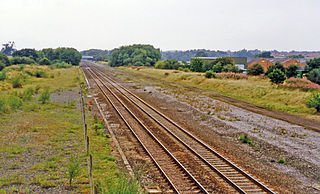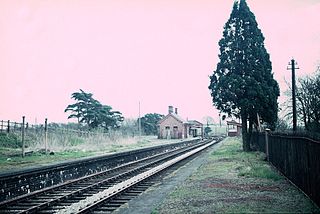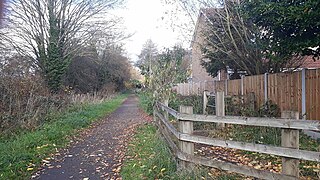
Ashton Park Parade railway station was a station on the line between Guide Bridge and Stalybridge in Greater Manchester, England. This station served the town of Ashton-under-Lyne, now served only by Ashton Charlestown, north of this former station.

Llandderfel railway station in Gwynedd, Wales, was a station on the Ruabon to Barmouth line. It closed to passengers ahead of the scheduled closure date of Monday 18 January 1965 because of flooding by the River Dee which breached the line near Llandderfel on 14 December 1964. This section of the line was never re-opened. The station had a signal box and was a passing place on the single line. Today, no trace of the station buildings exist; however, the flight of steps that leads from the road overbridge down to where the platforms once were are still in situ, along with a small section of overgrown "up" platform a few yards up from the steps.

Finedon railway station was built by the Midland Railway in 1857 on its extension from Leicester to Bedford and Hitchin.
There are 22 disused railway stations on the Bristol to Exeter line between Bristol Temple Meads and Exeter St Davids. The line was completed in 1844 at which time the temporary terminus at Beambridge was closed. The most recent closure was Tiverton Junction which was replaced by a new station} on a different site in 1986. 12 of the disused stations have structures that can still be seen from passing trains.

Turton and Edgworth railway station, located at 4 miles, 856 yards from Bolton, on the Bolton to Blackburn line, opened as Chapel Town Station. The short length original low height platform seen in early photographs at the front of the station building are replicated exactly at Bromley Cross, itself known to have opened in June 1848. Permanent station buildings were provided along the line in 1859, constructed with locally quarried sandstone, by Joseph Greenup and Co of Manchester. The original minutes of the railway company held at National Archives, Kew, reveal that the engineers drew up the plans for the 1859 building at Chapel Town and minute 273, dated 25 May 1859, reveals that tenders were sought for a station and detached cottage and loading shed at Chapel Town, at an estimated cost of £500. The 'detached cottage' survives as a private house close to the automated level crossing and the distinct two-half structure there appears identical to that surviving at the former Oaks Station, down the line towards Bolton, both being built as part of the same contract.

Denver railway station was a station in Denver, Norfolk on the Great Eastern Railway route between King's Lynn and Cambridge, commonly known as the Fen Line. It was also the beginning of a small branch to Stoke Ferry.

Old North Road was a railway station on the Varsity Line which served the small village of Longstowe near Bourn in Cambridgeshire. As its name suggests, the station was located on the eastern side of the Old North Road, the A1198 road - a major Roman road which linked London with Lincoln. Opened in 1862, the station was located in a rural area and saw little passenger traffic; it closed together with the line in 1968.

Killamarsh Central is a former railway station in Killamarsh, Derbyshire, England.

Adderbury railway station served the village of Adderbury in Oxfordshire, England.

Peakirk railway station served the parish of Peakirk in Cambridgeshire.

Saxby railway station was a station serving the villages of Saxby and Freeby, Leicestershire. It was located between the two villages.

Honington railway station was a station in the village of Honington, Lincolnshire. It was located on junction with the line Grantham and Lincoln railway line and Grantham to Sleaford and Skegness It was closed for regular services on 10 September 1962 but was used occasionally until 1965. The disused platforms are still in situ.

Breadsall railway station was a former railway station in Breadsall, Derbyshire. It was opened by the Great Northern Railway on its Derbyshire Extension in 1878.

Etwall railway station is a disused railway station in Etwall, Derbyshire. It was opened by the Great Northern Railway on its Derbyshire Extension in 1878.

Egginton Junction railway station is a disused railway station in Egginton, Derbyshire.

Barnwell railway station is a former railway station in Barnwell, Northamptonshire on the former Northampton and Peterborough Railway line which connected Peterborough and Northampton.

Gretton railway station was a railway station near Gretton, Northamptonshire. It was on the Nottingham direct line of the Midland Railway of the Midland Railway. The steps up to the former platforms can still be seen, but the station building itself is in private ownership.

Wansford Road railway station was located in Northamptonshire serving the village of Wansford. It was some distance east of the village on the A47 road, although still nearer than the more important Wansford station of the London & North Western Railway. The station was built in 1867.

Welford and Kilworth railway station was a railway station serving Welford and the villages of North Kilworth and South Kilworth in Leicestershire, England. It was opened as Welford on the Rugby and Stamford Railway in 1850.

Great Linford railway station was a railway station on the Wolverton to Newport Pagnell line. It served the village of Great Linford, Buckinghamshire, which it was located a little to the northeast of. Built next to the Linford Wharf on the Grand Union Canal, the station opened to traffic in 1867. The station consisted of a brick built station building, and single platform. The station did not have a goods yard or sidings.



















